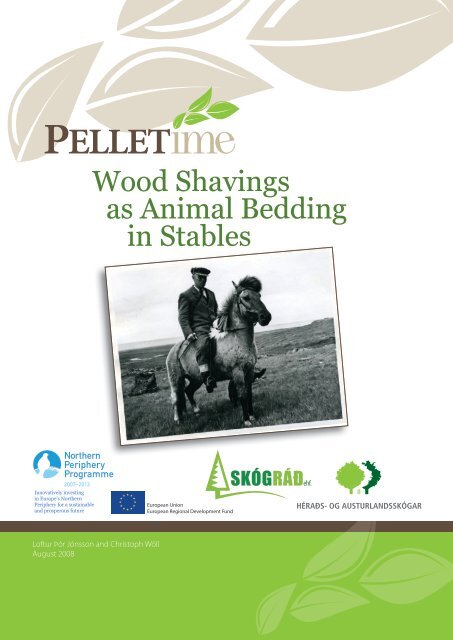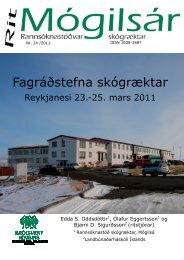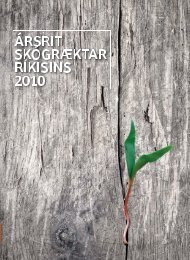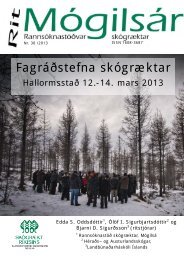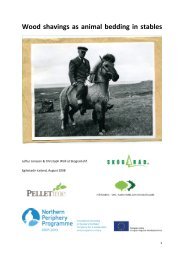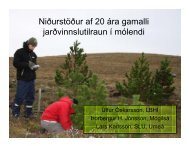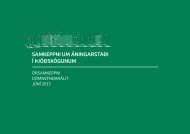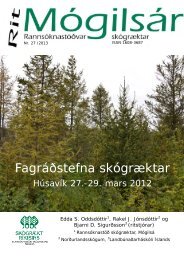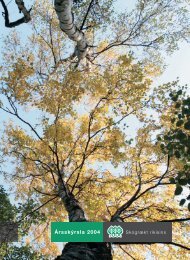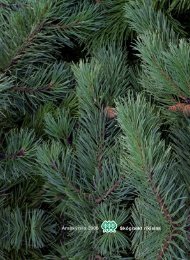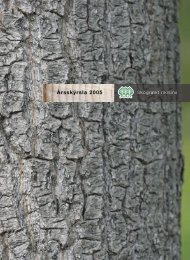Wood Shavings as Animal Bedding in Stables
Wood Shavings as Animal Bedding in Stables
Wood Shavings as Animal Bedding in Stables
Create successful ePaper yourself
Turn your PDF publications into a flip-book with our unique Google optimized e-Paper software.
<strong>Wood</strong> <strong>Shav<strong>in</strong>gs</strong><strong>as</strong> <strong>Animal</strong> <strong>Bedd<strong>in</strong>g</strong><strong>in</strong> <strong>Stables</strong>Innovatively <strong>in</strong>vest<strong>in</strong>g<strong>in</strong> Europe’s NorthernPeriphery for a susta<strong>in</strong>ableand prosperous futureXEuropean UnionEuropean Regional Development FundLoftur Þór Jónsson and Christoph WöllLoftur August Jonsson 2008 & Christoph WöllSkograd ehf.Egilsstadir Iceland1
Christoph Wöll. Forest science diploma from theTechnical University <strong>in</strong> Dresden, Germany 2008,started work<strong>in</strong>g for Skógráð ehf. <strong>in</strong> 2006.christoph@skograd.is , phone: +354 4712135Loftur Jónsson. M<strong>as</strong>ters degree <strong>in</strong> forestry fromthe Agricultural University <strong>in</strong> As, Norway 2000.From 2000 Mr. Jonsson worked for the IcelandicForestry Service and for regional afforestationprojects until 2004 when he founded Skograd ehf,Iceland’s first private consultant agency <strong>in</strong> the forestry sector. Heh<strong>as</strong> been <strong>in</strong>volved <strong>in</strong> several European and Nordic developmentprojects concern<strong>in</strong>g forestry, biom<strong>as</strong>s and energy.loftur@skograd.is , phone: + 354 4712135ContentsIntroduction.........................................................................................2<strong>Bedd<strong>in</strong>g</strong> <strong>in</strong> stables............................................................................3<strong>Wood</strong> products <strong>as</strong> bedd<strong>in</strong>g.......................................................3Products and producers...............................................................4<strong>Wood</strong> shav<strong>in</strong>g mills.........................................................................6Dry<strong>in</strong>g equipment, high temperature dryers.................7Low temperature dry<strong>in</strong>g..............................................................8Hestalist ehf..........................................................................................9Conclusion............................................................................................11Sources:...................................................................................................12IntroductionThis paper is written for the “Herad & Austurlandsskogar” reforestationproject <strong>in</strong> the e<strong>as</strong>t of Iceland. The reforestationproject consists of 140 private landowners who have beenplant<strong>in</strong>g commercial timber forests s<strong>in</strong>ce 1990. As the earlierplantations are now enter<strong>in</strong>g the first th<strong>in</strong>n<strong>in</strong>g stage, theproject is now concerned with market<strong>in</strong>g its timber products,especially low grade timber from first th<strong>in</strong>n<strong>in</strong>g. In order to doso, Heradsskogar h<strong>as</strong> jo<strong>in</strong>ed forces with other European organizationsunder the auspices of the EU-funded NPP (NorthernPeriphery Projects).The purpose of this paper is to <strong>in</strong>vestigate the production ofanimal bedd<strong>in</strong>g <strong>as</strong> a potential market for domestic timber <strong>in</strong>Iceland; to get an overview of products, production technologyand the market <strong>in</strong> Iceland.2
<strong>Bedd<strong>in</strong>g</strong> <strong>in</strong> stables<strong>Bedd<strong>in</strong>g</strong> denotes any material strewn <strong>in</strong> an animal’s enclosure(e.g. a stable). <strong>Bedd<strong>in</strong>g</strong> should have certa<strong>in</strong> properties.The bedd<strong>in</strong>g material should have a high absorbency of theanimal´s ur<strong>in</strong>e. As implied by the word, bedd<strong>in</strong>g should alsoprovide for a soft bed to prevent the animal from gett<strong>in</strong>g bedsores.More functions of bedd<strong>in</strong>g are to isolate downwardly andto provide a nonslip ground for the horse to stand on. The bedd<strong>in</strong>gshould not conta<strong>in</strong> harmful substances. To some extentdust can be harmful to the animal respiratory system, <strong>as</strong> well<strong>as</strong> mould, which can cause allergies. Sharp items can causetrouble for bigger animals. The most common bedd<strong>in</strong>g <strong>in</strong> stablesis straw. Although regarded <strong>as</strong> “the most natural bedd<strong>in</strong>g”by many farmers, it h<strong>as</strong> certa<strong>in</strong> disadvantages. Its absorbencyof 200 % (compared with dry matter) is moderate comparedwith other materials and ur<strong>in</strong>e is dra<strong>in</strong>ed rather than absorbed.The animals may also eat the straw, which often conta<strong>in</strong>s fungalspores and which, blended with excretions, often causescolic. Additionally, straw often conta<strong>in</strong>s a great deal of dust andneeds a lot of storage space.<strong>Wood</strong> products <strong>as</strong> bedd<strong>in</strong>gBecause of the shortcom<strong>in</strong>gs of straw, horse owners havelooked for better bedd<strong>in</strong>g materials. <strong>Wood</strong> products are themost common bedd<strong>in</strong>g alternatives to straw, <strong>in</strong>clud<strong>in</strong>g sawdust,wood shav<strong>in</strong>gs and granulated wood shav<strong>in</strong>gs. Sawdustcan generally be obta<strong>in</strong>ed from sawmills, where<strong>as</strong> wood shav<strong>in</strong>gsand their granulated form are delivered from producers <strong>in</strong>bales. What is important for all three products is that they orig<strong>in</strong>atefrom untreated wood. The ma<strong>in</strong> re<strong>as</strong>on for the use of woodbedd<strong>in</strong>g is that the majority of horses <strong>in</strong> stables have allergiesstemm<strong>in</strong>g from fungal spores and bacteria <strong>in</strong> straw bedd<strong>in</strong>g.While sawdust still conta<strong>in</strong>s a lot of dust, dust extracted woodshav<strong>in</strong>gs are suitable for horses with respiratory problems. Theyalso have a higher absorbency than straw, rang<strong>in</strong>g from 260%to 420%. In granulated form wood shav<strong>in</strong>gs can absorb evenmore liquid. For sawdust and wood shav<strong>in</strong>gs there are additionsavailable which conta<strong>in</strong> enzymes and bacteria that feedon ammonia: thus, the wet spots do not have to be removedbut can stay where they are, because the bacteria b<strong>in</strong>d the potentiallyharmful ammonia.3
Products and producersThe Austrian company Johann Pabst Holz<strong>in</strong>dustrie GmbH produces two different bedd<strong>in</strong>gs: AlpenSpan and AlpenSpan exquisite.Both are made of dedusted spruce shav<strong>in</strong>gs and conta<strong>in</strong> no additives (Fig. 1 and Table 1). In the stable AlpenSpan is used<strong>in</strong> the follow<strong>in</strong>g way: several bales are used to cover the previously cleaned ground; horse dropp<strong>in</strong>gs and wet places have to beremoved daily and the removed bedd<strong>in</strong>g h<strong>as</strong> to be replaced. The complete bedd<strong>in</strong>g h<strong>as</strong> to be removed after three months. Thesecond product, AlpenSpan exquisite, is enriched with enzymes and bacteria. The enzymes b<strong>in</strong>d ammonia, keep<strong>in</strong>g it from escap<strong>in</strong>g<strong>in</strong>to the air. Thus the bedd<strong>in</strong>g h<strong>as</strong> to be removed only twice a year and constitutes a good fertilizer afterwards. Both productscome precisely packed <strong>in</strong> heat-sealed bags, and are delivered on wrapped Euro-Pallets, which require little storage space.Table 1. Technical data for AlpenSpan and AlpenSpan exquisite bedd<strong>in</strong>g by the Johann Pabst Holz<strong>in</strong>dustrie GmbH.AlpenspanAlpenspan exquisiteBag size <strong>in</strong> cm 80x40x40 80x40x40Weight 20.5 kg 20 kgPackag<strong>in</strong>g volume 120 l 120 lScatter<strong>in</strong>g volume 430 l 500 lWater content Max. 11 % Max. 11 %Consumption per horse per week Approx. 1,5 bales Approx. 1 balepH value of the dung 7.8 7.8Used raw material Untreated spruce Untreated spruceAbsorb<strong>in</strong>g capacity M<strong>in</strong>. 300 % M<strong>in</strong>. 300 %Nitrogen Max 0.3 % Max 0.3 %Factory price per bale 5,40 € 7,20 €Fig. 1 & 2. AlpenSpan bales and the mach<strong>in</strong>e used to shave the wood.The American company <strong>Wood</strong>y Pet, which accord<strong>in</strong>g to its homepage is the largest and most reliable bedd<strong>in</strong>g supplier <strong>in</strong> theUS, sells granulated wood shav<strong>in</strong>gs under the name Professional animal bedd<strong>in</strong>g. Dur<strong>in</strong>g the production process most of theres<strong>in</strong>s, oils, tars and acids are extracted from the wood fiber, leav<strong>in</strong>g the wood fiber <strong>in</strong> sterile granulated form. The product h<strong>as</strong> anabsorbency of over 300 % and comes <strong>in</strong> two different sizes: while the smaller bags weigh 30 pound (13.6 kg), the bigger bags are4
delivered on 100 x 120 cm pallets (see figures 3 & 4). One 30pound bag costs 3.33 Canadian Dollar <strong>in</strong> the onl<strong>in</strong>e store (not<strong>in</strong>clud<strong>in</strong>g shipp<strong>in</strong>g costs); the suggested retail price is $6.95.Fig. 3 & 4. <strong>Wood</strong>y pet professional animal bedd<strong>in</strong>g <strong>in</strong> large andsmall bags.Another producer <strong>in</strong> North America is Canada-b<strong>as</strong>ed Horsecountry bedd<strong>in</strong>g Inc. Their product Magnum pellets is madeof p<strong>in</strong>e and spruce scrap. Dur<strong>in</strong>g production it is dried, compressedand formed <strong>in</strong>to small er<strong>as</strong>er-sized bits, result<strong>in</strong>g <strong>in</strong>sterilized, ple<strong>as</strong>ant smell<strong>in</strong>g, and soft-to-touch pellets. Amongthe advantages of its product, accord<strong>in</strong>g to the company’swebsite, their product conta<strong>in</strong>s less dust, bacteria (than straw)and tox<strong>in</strong>s (than hardwood), high absorbency and reducedstorage space. Pictures of the product are shown <strong>in</strong> Figures 5& 6.sift<strong>in</strong>g and dedust<strong>in</strong>g. Bales have a weight of 27 kg, a compressedvolume of 135 liter (80x40x40 cm bale size) and a volumeafter dispersion of 600 l. A bale costs around €9 ex factoryand for a 12 m 2 stable about 60 bales are needed per horse, peryear (€540 per horse per year). Ma<strong>in</strong>tenance of the bedd<strong>in</strong>gconsists of removal of the horse dropp<strong>in</strong>gs. The horse´s ur<strong>in</strong>eis absorbed by the bedd<strong>in</strong>g and the moist shav<strong>in</strong>gs provide amattress. The b<strong>as</strong>ic product comes with some variations: AllspanM<strong>in</strong>ispäne, which conta<strong>in</strong>s f<strong>in</strong>er shav<strong>in</strong>gs and sawdust forenhanced absorbency; and Allspan Fichte/Dougl<strong>as</strong>ie, which<strong>in</strong>cludes wood shav<strong>in</strong>gs from Dougl<strong>as</strong> fir (and larch), giv<strong>in</strong>g theblend a reddish color. Allspan bioaktiv, like Alpenspan exquisiteby Johann Pabst Holz<strong>in</strong>dustrie GmbH (see above), is enrichedwith enzymes and bacteria, b<strong>in</strong>d<strong>in</strong>g ammonia. Bale consumptionper horse and year is less than for the b<strong>as</strong>ic product andone bale costs about €9.50 ex factory (Fig. 4).Fig. 7 & 8. Allspan <strong>in</strong> stable and Allspan cl<strong>as</strong>sic baleFig. 5 & 6 Magnum pellets <strong>in</strong> 40 lb bags and stored on pallets.Allspan, a bedd<strong>in</strong>g producer from Germany, sells wood shav<strong>in</strong>gsboth with and without added enzymes and bacteria. Theb<strong>as</strong>ic product Allspan cl<strong>as</strong>sic is made from spruce and fir wood.The shav<strong>in</strong>gs are processed <strong>in</strong> conta<strong>in</strong>ed facilities by dry<strong>in</strong>g,5
<strong>Wood</strong> shav<strong>in</strong>g millsFor production of wood shav<strong>in</strong>gs there is a range of differentmach<strong>in</strong>ery and technology on the market. Some of the biggerones can even produce shav<strong>in</strong>gs from coarsed chips. Thetechnical pr<strong>in</strong>ciple for a small-scale shav<strong>in</strong>g mill is simple. A hydraulicarm moves a planer (which can have many blades) backand forth, shav<strong>in</strong>g the round wood to the desired thickness.Alternatively the blade is bolted, where the wood is movedback and forth over it, giv<strong>in</strong>g the same result. The shav<strong>in</strong>gs areusually fed <strong>in</strong>to a hammer-mill unit to break the shav<strong>in</strong>gs <strong>in</strong>tothe desired size before dry<strong>in</strong>g.Fig. 9 <strong>Wood</strong> shav<strong>in</strong>g mill by Jackson Lumber Harvester Co., Inc.Table 2. Technical data for wood shav<strong>in</strong>g mills by Jackson LumberJackson Lumber Harvester Co., Inc., b<strong>as</strong>ed <strong>in</strong> Wiscons<strong>in</strong> produceswood shav<strong>in</strong>g mills of different sizes. The technical data forthe smaller mach<strong>in</strong>es can be seen <strong>in</strong> table 2 and a picture of <strong>as</strong>hav<strong>in</strong>g mill <strong>in</strong> figure 9.In Germany the company Hombak also produces shav<strong>in</strong>g millsof different sizes. Among them is one shav<strong>in</strong>g mill constructedespecially for animal bedd<strong>in</strong>g. The smallest version weighs 29tons and processes up to 6 t dry matter per hour, and thusmight be too big for Iceland. The company produces anothermuch smaller shav<strong>in</strong>g mill, called ZOA 18, not especially for animalbedd<strong>in</strong>gs, though.6
Dry<strong>in</strong>g equipment, hightemperature dryersAs mentioned earlier, the shav<strong>in</strong>gs have to be dried before theycan suit their purpose. There is a v<strong>as</strong>t array of dryers, but mostshav<strong>in</strong>g equipment producers recommend the use of rotarydrum dryers for light materials like shav<strong>in</strong>gs. The most commondrum dryers are simple p<strong>as</strong>s and triple p<strong>as</strong>s drum dryers.Simple p<strong>as</strong>s drum dryers consist of a rotat<strong>in</strong>g horizontal drumof vary<strong>in</strong>g length and diameter (lengths vary from 4 to 12 mand diameters from 1 to 3 m). The drum rotates with 1 to 5rotations per m<strong>in</strong>ute and exhaust fumes from a connected fir<strong>in</strong>gare led through the drum. The shav<strong>in</strong>gs enter the slightly<strong>in</strong>cl<strong>in</strong>ed drum through a paddle and stay <strong>in</strong>side for app. 20 to30 m<strong>in</strong>utes. The shav<strong>in</strong>gs are constantly lifted by shovels andthe construction form of the drum provides that the biggershav<strong>in</strong>gs stay longer <strong>in</strong>side the drum. The dry<strong>in</strong>g takes place byconvective heat transfer and the heated drum parts.The triple p<strong>as</strong>s drum dryer is most suitable for very light materials.The difference to the simple p<strong>as</strong>s dryer is that the triple p<strong>as</strong>sdryer consists of three concentric cyl<strong>in</strong>ders, which are mechanically<strong>in</strong>terlocked to rotate at the same speed (see Fig. 8 and 9).The shav<strong>in</strong>gs are repeatedly carried to the top of each cyl<strong>in</strong>derby <strong>in</strong>ternal and external flights so they are constantly showeredthrough the hot g<strong>as</strong>. Moisture is given off cont<strong>in</strong>ually <strong>as</strong>they move along the hot air stream. Heavier, wetter particlesmove slower than f<strong>in</strong>e particles forward through the centercyl<strong>in</strong>der (red), back through the <strong>in</strong>termediate cyl<strong>in</strong>der (orange)and aga<strong>in</strong> forward through the outer cyl<strong>in</strong>der (blue) to the fanat the discharge end. The warm damp exhaust g<strong>as</strong>es are separatedfrom the dried product <strong>in</strong> the primary cyclone collector,and fall out the bottom onto a shaker screen to remove f<strong>in</strong>es.There are a big number of producers of drum dryers both <strong>in</strong>Europe and <strong>in</strong> North America.Producer Country RemarkAllgaier Werke GmbH Germany Also sells usedequipmentStela Laxhuber GmbHDieffenbacher groupGermanyGermanyOnix corporation U.S. Also sells usedequipment, h<strong>as</strong> dryers<strong>in</strong> many different sizesand their homepagefeatures a tool tocalculate the right sizefor <strong>in</strong>dividual purposesEnergy unlimited U.S. Also sells usedequipment andsawdust burnersJackson lumberharvester woodshav<strong>in</strong>g millsAaron equipmentcompanyU.S.U.S.Table 3. Producers of drum dryersAlso sells usedequipment and suit<strong>in</strong>gburnersIs a market for usedequipment, offer<strong>in</strong>g 20used drum dryers atthe time of writ<strong>in</strong>gFig. 10 & 11. Triple-p<strong>as</strong>s drum dryer7
Hestalist ehfIn Mosfellsbær, the company Hestalist ehf produces woodshav<strong>in</strong>gs <strong>as</strong> bedd<strong>in</strong>g for chicken and horse farms. When thecompany w<strong>as</strong> started <strong>in</strong> 2000, the raw material for the bedd<strong>in</strong>gconsisted ma<strong>in</strong>ly <strong>in</strong> scrap from carpenters and DIY stores(=shav<strong>in</strong>gs and sawdust). Though still used dur<strong>in</strong>g summer,when the demand for bedd<strong>in</strong>g is smaller, <strong>as</strong> most horses aregraz<strong>in</strong>g outdoors, scrap is not the ma<strong>in</strong> raw material sourceanymore. The re<strong>as</strong>on for the reduction of the scrap share is thatbig suppliers of it, e.g. Byko, moved their production abroad.For the shav<strong>in</strong>g-mach<strong>in</strong>e, the raw material can b<strong>as</strong>ically be anyk<strong>in</strong>d of timber that is shaveable. Dur<strong>in</strong>g w<strong>in</strong>ter, when the demandfor bedd<strong>in</strong>g is higher, the company h<strong>as</strong> been import<strong>in</strong>gabout 90 m 3 of round wood per week from Europe and Russia.Preferred tree species have been spruce and p<strong>in</strong>e. Whenavailable, cardboard is mixed with the wooden substance. Thecardboard must be clean of any dirt. Therefore they only acceptleftovers from the pack<strong>in</strong>g <strong>in</strong>dustry but not second handcardboard from consumers. Industrial w<strong>as</strong>te timber from theconstruction <strong>in</strong>dustry cannot be used because of nails andsuch that will damage the blades and be<strong>in</strong>g unwanted <strong>in</strong> theproduct. The shav<strong>in</strong>gs can be mixed with paper and with shav<strong>in</strong>gsand sawdust from traditional wood process<strong>in</strong>g <strong>in</strong>dustries.<strong>Wood</strong> chips would probably not work <strong>in</strong> the Hestalist productprocess, but h<strong>as</strong> <strong>as</strong> yet not been tried. Except for occ<strong>as</strong>ionallycardboards, no other substances are added to Hestalist product.Fig. 15. Lumber Jack planer at HestalistAt arrival logs are cut to length at the factory. For the plann<strong>in</strong>gmach<strong>in</strong>e logs can be at maximum 1.3 m long. The logs are thenmanually laid <strong>in</strong> the planer one by one. The planer (a lumberjack, electrical unit) h<strong>as</strong> 6 blades and can process 30 m 3 per 12hour shift. On average it can run 30 hours between sharpen<strong>in</strong>gthe blades, but this depends on the raw material. If it is dry itwears the blades more, thus they have to be sharpened moreoften. Wet material is better for the blades, but the disadvantageis that it requires more energy <strong>in</strong> the dry<strong>in</strong>g process. Theshav<strong>in</strong>gs leav<strong>in</strong>g the planer have an approximately palm sizedarea but are only 1 to 2 mm thick. Mov<strong>in</strong>g on a conveyor beltthe strands enter a hammer<strong>in</strong>g unit where they are chopped<strong>in</strong>to smaller bits. For chicken bedd<strong>in</strong>g the shav<strong>in</strong>gs can be larger,where<strong>as</strong> for horse bedd<strong>in</strong>g they have to be f<strong>in</strong>er.After the hammer<strong>in</strong>g unit, the shav<strong>in</strong>gs enter an oil fired triplep<strong>as</strong>s drum dryer where they are dried and sterilized at 270-300°C (can be <strong>as</strong> high <strong>as</strong> 400 °C). The dryer w<strong>as</strong> orig<strong>in</strong>ally builtfor dry<strong>in</strong>g gr<strong>as</strong>s-pellets <strong>as</strong> livestock nutrient addition, but w<strong>as</strong>rebuilt by “Vélaverkstæði S<strong>in</strong>dra” for dry<strong>in</strong>g wood shav<strong>in</strong>gs. Dur<strong>in</strong>gthe dry<strong>in</strong>g process air is abducted to keep it from condens<strong>in</strong>gaga<strong>in</strong>. The capacity of the dryer is twice that of the lumberjackplaner or 60 m 3 per 12 hour shift. Because of the rise <strong>in</strong> oilprices Hestalist <strong>in</strong>tends <strong>in</strong> near future to change the oil burnerto a wood b<strong>as</strong>ed burner and they estimate that it will <strong>in</strong>cre<strong>as</strong>ethe demand for wood by about 10%. After leav<strong>in</strong>g the dryer9
Fig. 16. Raw material from Icelandic forestFig. 17. Pack<strong>in</strong>g unitthe shav<strong>in</strong>gs are left to cool for at le<strong>as</strong>t a few hours before itis moved to the pack<strong>in</strong>g unit by a small Bob Cat. The pack<strong>in</strong>gunit compresses the shav<strong>in</strong>gs <strong>in</strong>to a rectangular pl<strong>as</strong>tic bale,each conta<strong>in</strong><strong>in</strong>g 0.1 m 3 and weigh<strong>in</strong>g 30 kg. The f<strong>in</strong>ished productis e<strong>as</strong>y to stack and transport. The moisture content is vary<strong>in</strong>gfrom 12 -18%.Annual production is approximately 80.000 bales pr. year andthe buyers are big poultry farms (35.000 bales annually) andhorse farms (35.000 bales annually) and others for other uses10.000 bales pr. year. The company estimates the domesticmarket to be around 200.000 -220.000 bales used pr. year andgrow<strong>in</strong>g where<strong>as</strong> most of it is used for horse bedd<strong>in</strong>g. Theirmarket strategy is to produce 120.000 bales pr. year and thusdom<strong>in</strong>ate the market.Round wood imported from Europe and Russia h<strong>as</strong> been thema<strong>in</strong> raw material dur<strong>in</strong>g the l<strong>as</strong>t years. Recently the companyh<strong>as</strong> been shift<strong>in</strong>g its attention to Icelandic forests <strong>as</strong> a sourceof raw material supply. There are several re<strong>as</strong>ons for this development.One is that prices for round wood reached historicheights l<strong>as</strong>t year and are likely to stay high or rise even more:Russia h<strong>as</strong> put an export tax of €15 on round wood leav<strong>in</strong>gthe country and is probably go<strong>in</strong>g to raise the tax to €50, be<strong>in</strong>gtantamount to a ban on export of round wood. Add<strong>in</strong>g tothe cost of imported wood is the drop <strong>in</strong> the Icelandic Crown.Another re<strong>as</strong>on for the <strong>in</strong>terest <strong>in</strong> Icelandic timber is that roundwood enter<strong>in</strong>g the country h<strong>as</strong> to be debarked, which meansextra handl<strong>in</strong>g and extra cost compared to domestic raw material.The bark h<strong>as</strong> no damag<strong>in</strong>g effect on the product. Andf<strong>in</strong>ally there is an argument that us<strong>in</strong>g domestic timber enhancesthe image of Hestalist´s product. It is worth not<strong>in</strong>g thatlow grade timber (for example from first th<strong>in</strong>n<strong>in</strong>g, small diameterand crooked form) is usable <strong>in</strong> the process.10
ConclusionThe Aim of this paper h<strong>as</strong> been to get an overview of the production,technology and market of wood shav<strong>in</strong>gs <strong>as</strong> animalbedd<strong>in</strong>g <strong>in</strong> Iceland and raises more questions than it answers.There is clearly a market for timber (even for low grade- andsmall dimension timber) for domestic use of animal bedd<strong>in</strong>g.Already there is one factory, Hestalist ehf, <strong>in</strong> South West Icelandthat is produc<strong>in</strong>g a substantial part of the domestic animalbedd<strong>in</strong>g market (chicken and horses). This should give nearbyforest owners a good opportunity for sell<strong>in</strong>g their timber <strong>as</strong>Hestalist is now consider<strong>in</strong>g us<strong>in</strong>g more domestic raw material<strong>in</strong> their production. For other forest owners, e.g. <strong>in</strong> the NorthE<strong>as</strong>t of Iceland, the situation is more doubtful. Logistics are likelyto be very expensive due to long road transport of timber.But it is worthwhile to <strong>in</strong>vestigate this further, and especially:• For large enough quanta, might boat transport bepossible?• As the transport vehicles usually drive half emptyfrom E<strong>as</strong>t to South, perhaps it could be possible tonegotiate a lower road transport price?It is our conclusion that quality, of at le<strong>as</strong>t some of the Europeanand North-American products, is higher than Hestalist´sespecially <strong>in</strong> regard to moisture content, but also to granulat<strong>in</strong>g,dust clean<strong>in</strong>g and enrich<strong>in</strong>g the product with nitrogen absorbentbacteria. In price comparison, Hestalist is do<strong>in</strong>g well. Itis worth not<strong>in</strong>g that the company h<strong>as</strong> a unique market advantage<strong>as</strong> it also cleans out many of the big stables <strong>in</strong> the South-West of Iceland and is therefore already “<strong>in</strong>side” the market.Another possibility for forest owners <strong>in</strong> the North-E<strong>as</strong>t is to putup their own production l<strong>in</strong>e locally. How big such a factoryshould be depends mostly on logistics, <strong>as</strong> the local marketis probably quite small.All other th<strong>in</strong>gs be<strong>in</strong>g equal, a factory<strong>in</strong> North-E<strong>as</strong>t Iceland (compared to South-West Iceland)could have a market advantage <strong>in</strong> the E<strong>as</strong>t and North of Icelandand possibly the Faroe Islands. Transport of the f<strong>in</strong>ishedproduct compared to raw material timber should be cheaper<strong>as</strong> it is compressed <strong>in</strong> e<strong>as</strong>y to handle bales that can be stackedon Euro pellets <strong>as</strong> normal transport goods and the fact thatthere is no real <strong>in</strong>fr<strong>as</strong>tructure for timber logistics <strong>in</strong> Iceland. It isworth not<strong>in</strong>g that the strength of the North E<strong>as</strong>t region is rawmaterial supply compared to other parts of Iceland. This refersto the quantity of harvestable timber <strong>in</strong> the near future <strong>as</strong> well<strong>as</strong> the capability of forest operations.As the production unit-cost is largely <strong>in</strong>fluenced by the price ofenergy <strong>in</strong> the dry<strong>in</strong>g process, new and less energy demand<strong>in</strong>gtechnologies should be <strong>in</strong>vestigated. For example the SwedishRenergy LTK low temperature dryer runs on 60-80 °Celsius.This opens the possibility of us<strong>in</strong>g cheap geothermal water fordry<strong>in</strong>g.It should also be noted that the market situation is not clear.This refers both to the exist<strong>in</strong>g market and especially future development.A more detailed market survey would be usefulfor estimation of present status and future possibilities. Sucha survey should <strong>in</strong>clude buyer’s preferences to quality andprice levels. This could be done <strong>in</strong> cooperation with an educational/research<strong>in</strong>stitution such <strong>as</strong> the agricultural universitiesat Hvanneyri and/or Hólar where trials of different qualities ofbedd<strong>in</strong>g could be rated and evaluated.Loftur Jonsson & Christoph WöllEgilsstaðir, August 200811
Sources:Hestalist ehf, Flugumýri 26 , 270 Mosfellsbær, Tel. 5868260 and 8927149http://www.alpenspan.at/en/produkte.phphttp://www.woodypet.com/horse.htmlhttp://www.horsecountrybedd<strong>in</strong>g.com/magnum.htmhttp://www.allspan-onl<strong>in</strong>eshop.de/http://www.jacksonlbrharvester.com/http://www.hombak.de/pdf/pdf_DE/Tiere<strong>in</strong>streu.pdfhttp://www.hombak.de/pdf/pdf_DE/ZOA.pdfhttp://www.allgaier.de/verfahrenstechnik/trockner/e<strong>in</strong>satzbeispiele/<strong>in</strong>dex.php?de&page=2http://stela.de/content_englisch/trommeltrockner_e/drum_drier_e.htmhttp://www.dieffenbacher.de/pdf/prospekte/Trommeltrockner_dt.pdfhttp://www.theonixcorp.com/rotary.htmlhttp://www.energyunlimited<strong>in</strong>c.com/dryers.htmlhttp://www.aaronequipment.com/UsedEquipment/Dryers+-+Dry<strong>in</strong>g+Equipment/Drum+Dryers.htmlhttp://www.saveenergy.ch/de/trockner/trockner.phphttp://www.sre.se/eng/torksystem.htmlInnovatively <strong>in</strong>vest<strong>in</strong>g<strong>in</strong> Europe’s NorthernPeriphery for a susta<strong>in</strong>ableand prosperous futureXEuropean UnionEuropean Regional Development Fund12


